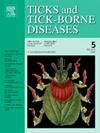Hyalomma aegyptium: Observed global distribution, imported specimens, preferred hosts and vector competence
IF 3.4
2区 医学
Q2 INFECTIOUS DISEASES
引用次数: 0
Abstract
The tortoise tick Hyalomma aegyptium (Linnaeus, 1758) is a three-host tick, predominantly infesting land tortoises of the genus Testudo. A database was compiled, resulting in 557 H. aegyptium georeferenced locations in the Palearctic. This dataset covers the entire range of H. aegyptium for the first time. Thus, the natural distribution area of H. aegyptium extends from Morocco in northwestern Africa to Kyrgyzstan in Central Asia between 10° W–73° E and 28–46° N, which is shown in an overview map and four detailed maps covering North Africa, the Balkans, the Near East, and the Middle East. In addition, documented findings on land tortoises that have been exported worldwide as popular pets give an impression of the occurrence of H. aegyptium outside its natural distribution. The host species is known from 424 mapped H. aegyptium locations, which can be ranked as follows: 92.9% Testudo spp., 4.0% mammals (mainly hedgehogs and hares), 1.7% humans, 0.9% lizards and 0.5% birds. If only tortoise hosts are considered, these are 92.6% Testudo graeca, 3.8% Testudo hermanni, 2.8% Testudo horsfieldii and 0.8% Testudo marginata. It is striking that no infestation with H. aegyptium has been detected on Testudo kleinmanni in their natural habitat, but it was detected on imported specimens in Malta and the USA. Although numerous tick-borne pathogens have been detected in H. aegyptium, vector competence, i.e. the experimentally proved transmission of pathogens from the vector to the host, could only be demonstrated for three pathogens. These are the two blood parasites Hemolivia mauritanica and Hepatozoon kisrae as well as Coxiella burnetii, the causative agent of Q fever.
埃及透明体:观察到全球分布、进口标本、首选宿主和媒介能力。
埃及透明蜱(Linnaeus, 1758)是一种三宿主蜱,主要寄生于龟属陆龟。建立了一个数据库,在古北极找到了557个埃及古猿的地理参考位置。该数据集首次覆盖了埃及嗜血杆菌的整个范围。因此,埃及弧菌的自然分布区从非洲西北部的摩洛哥延伸到中亚的吉尔吉斯斯坦,范围在10°W-73°E和28-46°N之间,这在一张概览图和四张覆盖北非、巴尔干、近东和中东的详细地图中得到了体现。此外,对作为受欢迎宠物出口到世界各地的陆龟的记录发现,给人的印象是埃及血吸虫在其自然分布之外的存在。在绘制的424个埃及伊蚊分布点中,已知的寄主种类排序如下:家鼠92.9%,哺乳动物(主要是刺猬和野兔)4.0%,人类1.7%,蜥蜴0.9%,鸟类0.5%。如果只考虑陆龟寄主,这些寄主分别是92.6%的灰斑斑试验鼠、3.8%的hermanni试验鼠、2.8%的horsfieldii试验鼠和0.8%的边际试验鼠。令人惊讶的是,在其自然栖息地未检测到埃及伊蚊,但在马耳他和美国的进口标本中检测到埃及伊蚊。虽然在埃及伊蚊中发现了许多蜱传病原体,但媒介能力,即实验证明的病原体从媒介向宿主的传播,只能证明三种病原体。这是两种血液寄生虫,毛里塔尼亚嗜血杆菌和以色列肝虫,以及Q热的病原体伯纳蒂克希菌。
本文章由计算机程序翻译,如有差异,请以英文原文为准。
求助全文
约1分钟内获得全文
求助全文
来源期刊

Ticks and Tick-borne Diseases
INFECTIOUS DISEASES-MICROBIOLOGY
CiteScore
6.90
自引率
12.50%
发文量
185
审稿时长
6-12 weeks
期刊介绍:
Ticks and Tick-borne Diseases is an international, peer-reviewed scientific journal. It publishes original research papers, short communications, state-of-the-art mini-reviews, letters to the editor, clinical-case studies, announcements of pertinent international meetings, and editorials.
The journal covers a broad spectrum and brings together various disciplines, for example, zoology, microbiology, molecular biology, genetics, mathematical modelling, veterinary and human medicine. Multidisciplinary approaches and the use of conventional and novel methods/methodologies (in the field and in the laboratory) are crucial for deeper understanding of the natural processes and human behaviour/activities that result in human or animal diseases and in economic effects of ticks and tick-borne pathogens. Such understanding is essential for management of tick populations and tick-borne diseases in an effective and environmentally acceptable manner.
 求助内容:
求助内容: 应助结果提醒方式:
应助结果提醒方式:


